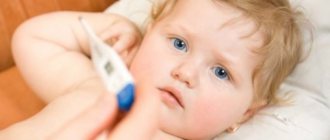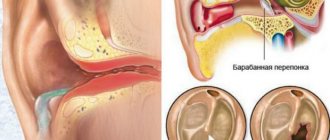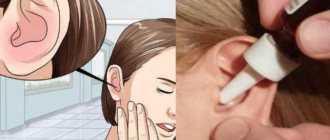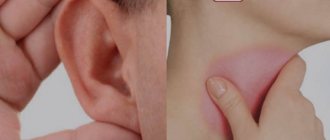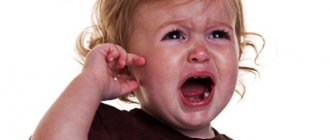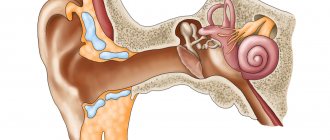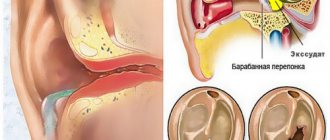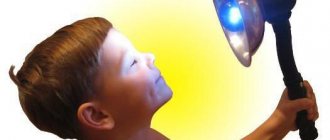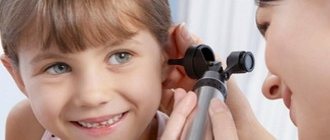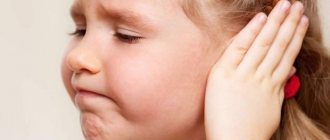The most common suppurative otitis media occurs in children. Moreover, in most cases it is recurrent. There are certain factors that can cause the development of otitis media in a child. These may be frequent infectious diseases, enlarged adenoids, or a weakening of the body's defense system.
Signs of pathology should be the basis for contacting a specialist. The doctor will make the correct diagnosis and prescribe the correct treatment for purulent otitis in a child, aimed not only at eliminating otitis, but also the causes that caused it.
Description
Otitis media refers to an inflammatory process in the middle part of the ear, which is part of the auditory system. Its main part is the eardrum, which is a small space in the temporal bone that is responsible for processing sound vibrations entering the ear.
Purulent otitis in children can cause pathologies in the development of the child’s speech functions. In some cases, the disease can disrupt psycho-emotional development, reduce sensitivity to information and significantly reduce the quality of life in general.
This form of otitis is characterized by inflammation of the mucous membrane of the ear, accompanied by the production and accumulation of characteristic discharge. Purulent otitis is somewhat more dangerous than catarrhal, as it can lead to complications such as hearing loss or intracranial changes. If a child has suffered from this form of otitis, then you should definitely have your hearing checked and be attentive to any changes in the psycho-emotional plane.
Causes
The most common causes of the development of purulent otitis in children are an inflammatory process in the nasopharynx, chronic rhinitis, adenoids and ARVI. These diseases cause excess mucus to accumulate in the nose.
When a child intensively blows his nose, mucus penetrates the Eustachian tube and blocks it. This leads to a lack of ventilation, and subsequently to infection and inflammation of the ear mucosa.
When the accumulated inflammatory fluid is released, severe discomfort, pain and hearing loss occur. At this stage, pathogenic microorganisms begin to actively multiply. As a result, after a couple of hours or several days, pus begins to come out of the ear.
At the same time, the child’s well-being deteriorates significantly. Body temperature may rise. At the same time, the intensity of painful sensations in the ear area increases. The eardrum may rupture under pressure from pus.
What signs can be used to identify bilateral otitis media in children?
Much depends on what form this disease is in at the moment. Symptoms of bilateral otitis media in children may vary to some extent.
In the acute form, slight swelling and severe redness of the skin occurs at the site of the lesion. In some cases, translucent liquid begins to leak out, and a narrowing of the ear canal is observed. In addition, at the very beginning of the disease, the child may complain of ringing, congestion and constant noise in the ears.
Then other symptoms appear, such as increased body temperature, severe and acute pain. In the absence of treatment, a rupture of the eardrum occurs, and instead of a translucent liquid, purulent greenish-yellow exudate flows out. At this time, the temperature rises to 38 degrees and remains at this level. The pain intensifies, becomes shooting and can radiate to the eyes and also to the larynx.
In infants, it is not easy to determine the symptoms of bilateral otitis media, since babies cannot yet tell their parents what exactly is bothering them, but even in this case, observant parents can identify the disease. The baby may completely refuse food, throws his head back, shakes it from side to side, and constantly cries. In very young children, all these symptoms may be accompanied by a strong fever, diarrhea, or sudden vomiting.
Why in a child?
There are several reasons why purulent otitis media is diagnosed in children and not in adults. These include the following:
- An anatomical feature of the Eustachian tube in a child is its narrowness, which makes it easily clogged with mucus.
- Enlarged adenoids are most common in children. Such formations can also compress the Eustachian tube, which narrows its lumen.
- Children are more susceptible to acute viral infectious diseases than adults.
Drug treatment
Before starting drug therapy, it is necessary to carry out all diagnostic measures suggested by the attending physician. It is the timely establishment of the correct diagnosis and the cause of bilateral otitis in a child that guarantees a favorable prognosis, prevents the occurrence of severe complications and transition to a chronic disease. It is necessary to once again emphasize that only the attending physician should determine the list of medications needed for treatment and their dosage. As is known from medical practice, the treatment of bilateral otitis in children is complex and has different directions and goals.
Provoking factors
Also, the risk of developing bilateral purulent otitis media in a child is significantly increased by some additional factors, for example:
- Vitamin deficiency in the body.
- Hypothermia.
- Long-term use of a drug belonging to the group of antibiotics.
- Fluid getting into the ear.
- Reduced immunity.
Types and symptoms
There are several types of this disease:
- Acute purulent otitis media is the initial stage of ear inflammation in children.
- Otitis externa affects the outer ear (concha and meatus). It appears in two forms: limited and diffuse (the inflammatory process occurs throughout the outer ear).
- Labyrinthitis (inflammation of the inner ear) occurs in acute or chronic forms. This is a serous, purulent or necrotic inflammatory process that can be limited or diffuse.
Important! If symptoms of otitis media are detected in a child, you should immediately consult a doctor.
The presence of the disease can be determined by the following symptoms:
- anxiety;
- cry;
- weakness;
- refusal to eat;
- pain in the ears;
- elevated temperature;
- hearing impairment;
- suppuration.
Purulent otitis in a child: symptoms
The development of a purulent form of otitis in childhood is characterized by severe pain in the ear. A child with such an illness tends to show anxiety and tearfulness. The nature of the pain can be different: aching, throbbing and cutting.
Other symptoms:
- Ear discomfort increases significantly at night, which can lead to sleep disturbances. In addition, children often exhibit the following symptoms:
- Weakness of the whole body.
- Pale skin.
- Hearing impairment.
- Purulent discharge mixed with blood.
- Increased body temperature.
Symptoms of purulent otitis media in a child must be identified in a timely manner. It is easier to identify pathology in older children, who can show exactly where it hurts.
Clinical manifestations
A child under 2 years of age is not able to tell his parents about unpleasant sensations in the ear. In this regard, parents pay attention to the pathology already during perforation of the membrane and evacuation of pus into the external ear canal. It must be taken into account that untimely therapy can provoke unpleasant consequences and deafness.
It is not difficult to establish the presence of a bilateral form of otitis. Manifestations of the disease are: runny nose, inflammation and pain in the nasal cavity, hyperthermia and malaise. In addition, there are special symptoms of the disease:
- discomfort in the ear;
- pus with a foul odor;
- increase in body temperature up to 39 degrees;
- pain in the head;
- deterioration of hearing function;
- loss of appetite;
- cry.
The bilateral form of the disease in childhood often occurs atypically and is characterized by the manifestation of all the signs of the pathological process at once.
In newborns
With newborn children everything is much more complicated. Purulent otitis media can lead to the baby constantly crying and practically not sleeping. In addition, the following symptoms appear:
- Loss of appetite.
- The appearance of a gag reflex.
- The child cannot lie on his side on the side of the affected ear.
If, against the background of a complaint of pain in the ear, the temperature rises, you should call an ambulance, since this combination is very dangerous for the child due to the risk of complications.
Diagnosis and types
When determining the diagnosis, the specialist relies on the patient’s complaints, his medical history, as well as the results of otoscopy. As a rule, the following types of examinations are prescribed:
- Inspection, endoscopic examination of the nose, nasopharynx and ear cavity after cleaning the canals.
- Vestibulological and audiological examination.
- Valsalva maneuver. During the manipulation, exudate is pushed into the ear canal.
- Study of secretion in laboratory conditions. Its purpose is to assess the susceptibility of harmful microorganisms to antimicrobial drugs.
- Assessing the patient's immune system.
- X-ray and computed tomography.
There are several types of purulent forms of otitis in children. Each of them is characterized by certain features.
Acute - it is characterized by severe pain and accumulation of purulent discharge in the ear cavity. In the absence of timely treatment, there is a risk of the disease becoming chronic. With this type of otitis, the eardrum is affected. There is also a gradual decline in the child’s hearing function.
Bilateral - in this case, both ears are exposed to inflammatory infection at once. This species is very dangerous for the health of a child, especially a newborn. The vast majority of otitis in this category of children are bilateral. With age, the hearing aid develops, and the number of otitis media decreases.
Recurrent - this type is characterized by re-infection a short period of time after recovery. Most often this happens due to incorrectly chosen therapy or violation of the attending physician's instructions. Recurrences of otitis media cannot be ruled out with enlarged adenoids.
Purulent otitis in a child: treatment
To avoid dangerous health consequences, you must promptly consult a doctor and undergo an examination. The specialist selects a treatment regimen taking into account the patient’s complaints and the stage of manifestation of the disease. The duration of therapy also depends on this.
Antibacterial drugs are prescribed to newborn children with purulent otitis media. Depending on the patient’s age and type of disease, antibiotics may be prescribed in tablet or suspended form. Most often, drugs from the penicillin group are prescribed, especially in combination with clavulanic acid.
How long does it take to treat purulent otitis media in children? It depends on the severity of the disease. On average, the disease goes away within a week.
The most effective drugs are: Amoxicillin, Amoxiclav, Augmentin, etc. If penicillins are ineffective or contraindicated, preference is given to cephalosporins, such as Ceftriaxone, Cefazolin, etc.
If these drugs do not produce results or an allergy to them is detected, specialists prescribe drugs from the macrolide group. These are drugs such as Azithromycin, Clarithromycin, etc. An antibiotic for purulent otitis media in children should be selected by a doctor. Self-medication is unacceptable.
For purulent otitis media, the child must be prescribed nasal drops that narrow the blood vessels. They relieve swelling from the nasal mucosa and expand the lumen of the auditory tube. These may be Otrivin, Galazolin, Naphthyzin, etc. Antihistamines are also prescribed in combination with drops for purulent otitis media in children.
If the pain is intense, anti-inflammatory drugs based on ibuprofen or paracetamol are prescribed. They also have an antipyretic effect. Both suppositories and syrups can be used.
If perforation of the eardrum has not been detected, drops are prescribed in the ear. Otipax has an analgesic and anti-inflammatory effect. The drug is prescribed even to infants.
In the chronic form of purulent otitis, the use of immunomodulators and antiviral drugs, such as Viferon, is indicated.
This is how purulent otitis in children is treated.
Stages of bilateral otitis media
The catarrhal type of the disease is manifested only by redness, swelling and intermittent ear pain radiating to the cheeks, temples, and neck. The intensity of inflammation and the resulting sensations depends on the age of the child. Unlike the catarrhal form, exudative otitis media in children is accompanied by purulent or serous discharge.
Serous otitis media occurs as an acute inflammation of the middle ear with the formation of mucus in the tympanic cavity. The disease often takes a chronic form: the ear begins to hurt after cooling, with a mild cold, or inhaling polluted air.
Symptoms of bilateral exudative otitis in a child, depending on the phase of the inflammatory process:
- At the first stage, ear pain appears, hearing is weakened, body temperature rises, fatigue, weakness, and lethargy occur.
- In the second stage, the eardrum is perforated in one ear or both; The child’s pain and temperature subsides, and hearing loss persists.
- At the third stage, ear discharge and pain stop, hearing is restored, and the perforation in the eardrum is scarred.
A purulent type of bilateral otitis media in a child is more common when the immune system is weakened. The malaise is manifested by headache, weakness and dizziness. The pain in the ears is aching at first, then intensifies. Shooting pains appear in the evening or at night.
After a sharp increase in temperature, perforation of the eardrum quickly occurs. Pus flows from the child's ears, and the pain suddenly goes away.
The formation of mucus or purulent masses is directly related to inflammation of the middle ear. Fluids cannot always break through the eardrum on their own. To facilitate this process, paracentesis is performed in the doctor's office. The specialist makes a puncture under local anesthesia and uses a special instrument. A point on the eardrum is selected that is most favorable for the release of pus. The artificial hole heals faster.
Prevention
If the disease has taken a recurrent form, then the factors influencing the appearance of purulent otitis should be eliminated. Most often, it is necessary to strengthen the immune system; for this, immunomodulatory and vitamin therapy is carried out.
When remission occurs, a procedure is carried out to blow out the auditory tubes and massage the eardrum. To eliminate sinusitis, a puncture may be performed. If the cause of frequent relapses is enlarged adenoids, the doctor may prescribe their removal.
It must be remembered that the consequences of purulent otitis media in children are very dangerous. Meningitis and sepsis may develop.
To avoid the development of a purulent form of otitis, special preventive measures are taken. They are as follows:
- Strengthening the immune system.
- Hardening.
- Prevention of viral infections.
- Balanced diet.
- Timely treatment of nasopharyngeal diseases.
Purulent otitis media belongs to the category of dangerous diseases that affect auditory function. Therefore, if you complain of pain in the ear, you should show your child to a specialist and not self-medicate.

